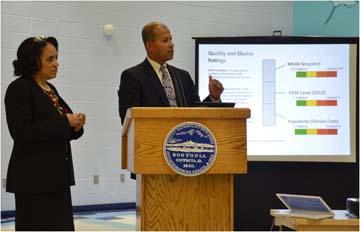September 26, 2012

Deputy Superintendent Michael Goar, right, and BPS Superintendent Dr. Carol Johnson spoke during Monday evening's meeting at the Frederick Middle School. Photo by Chris Lovett
Parents, take your pick. Boston School Department officials this week outlined five proposals that would move the city away from a three-zone set-up for assigning students to schools beginning with the 2014-2015 school year at the earliest.
The proposals, which were introduced Monday night at the Frederick Pilot Middle School and will be aired at a series of public meetings beginning with one Thursday at 7 o’clock at the Jeremiah E. Burke High School on Washington Street near Grove Hall, aim to send elementary and middle school students to classrooms closer to home instead of scattering children living on the same street across the city to various schools.
Related commentary: Towards a 'common-sense' system for school choice, by Mayor Thomas Menino
In that context, Superintendent Carol Johnson pointed to a vivid example of the vagaries of the current assignment process: nearly 2,000 students in the Bowdoin-Geneva section of Dorchester attend 102 different schools.
The proposed models include maps that would divide the city into 6 zones or 9 zones or 11 zones or 23 zones; and a proposal with no zones. The city’s high schools would remain city-wide under all plans.
The current three-zone plan, in place since 1988, includes South Boston, Dorchester, Mattapan, and Hyde Park in one zone, West Roxbury, Jamaica Plain, Roxbury, and Roslindale in the second, and Allston-Brighton, Fenway, Back Bay/Beacon Hill, South End, Charlestown, and East Boston in the third.
Under the proposed 6-zone plan, for example, one zone would include most of Dorchester and part of Mattapan, while the rest of Mattapan would share a zone with Hyde Park and West Roxbury.
In the proposed 9-zone map, Dorchester would be halved, and one zone would include Dorchester and Mattapan.
Those two maps are the only ones that hit all of the “framework goals” laid out by school officials: diversity, transportation savings, ease of execution, how close to home it is for students, and how much choice parents get.
A 27-member advisory committee, appointed by the mayor, is weighing the proposals, as is the Boston School Committee, which is also mayorally appointed and will sign off on a final plan in December.
Mayor Thomas Menino attended the Monday night meeting and called the evening a “little bumpy” – school department officials came in for criticism from some of the 150 audience members and some on the advisory committee for not including “quality” in the framework goals – while noting that more input is “great,” and adding, “We don’t want this thing just to be rushed through.”
Asked by the Reporter on Tuesday if there were any proposals he felt should be off the table, Menino pointed to the no-zone and the 23-zone offerings. At a neighborhood meeting at First Parish Church later in the day, he was asked by another reporter about the five plans, from the 23-zones to the no-zones. “Somewhere in between is a plan that is going to make our school system a better school system,” he said.
In the end, Menino said, whichever plan is approved will be used as a “whipping boy” by some politicians. “Of course, it’s not the perfect plan. But we’re not saying it’s the perfect plan. It’s the beginning of a new plan,” he said to the Reporter.
Menino pledged in his State of the City speech earlier this year to radically overhaul the current 3-zone school assignment system, which has been a constant source of frustration for parents. On Monday, he said that the process school officials set up for overhauling the assignment system – the 27-member committee, the 2,300 families who weighed in over the summer, and the meetings this the fall – is “probably the best process we ever put together. Of course, we’re going to hear the loud screaming, throwing rocks, because it makes headlines,” Menino said. “It’s not about headlines, it’s about the kids. We’re doing this for the kids, we’re doing it for the future of Boston.”
The final plan will need support from Boston’s communities of color. On Thursday, outside the school department’s headquarters on Court St., a coalition of minority groups plans to hold a press conference and critique the five proposals.
The coalition includes the Boston branch of the NAACP, the Lawyers Committee for Civil Rights and the Union of Minority Neighborhoods, among others. The press conference is set for 10 a.m.
At the Frederick School, school officials noted that each proposal offers unique challenges and opportunities. Deputy Superintendent Michael Goar noted that the no-zone plan does not provide many choices to parents, but it does allow for predictability and closeness to home for parents and their children.
Marie St. Fleur, a top Menino aide and a former state representative, said she needed to study the proposals while at the same time noting that she had a “very different reaction” to the proposals than was the case the last time the Menino administration attempted to change the assignment system.
School officials took diversity and closeness-to-home into account this time, she said, calling it a “very good start.” Asked if any proposal stood out to her, St. Fleur said the 6-zone plan appears to keep neighborhoods together.
Other elected officials, like state Sen. Sonia Chang-Diaz and City Councillor John Connolly, who both have shown intense interest in education issues, said they were still sifting through the data.
Connolly, who chairs the City Council’s Education Committee, said the debate was being driven toward the 6-zone and 9-zone proposals. The question, he said, is whether there is a “better avenue” to balance closeness-to-home with parental choice and a predictability for parents.
More information is available at the school department’s website, BostonSchoolChoice.org.
Topics:


